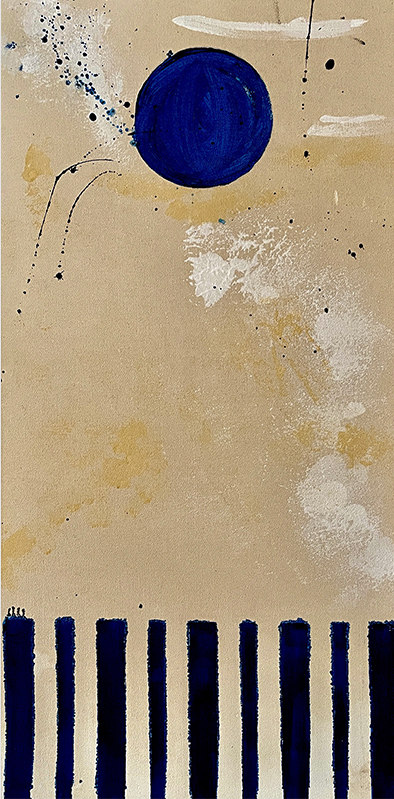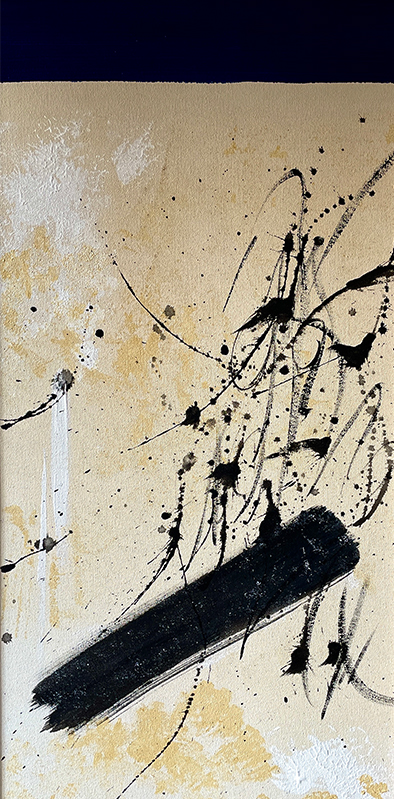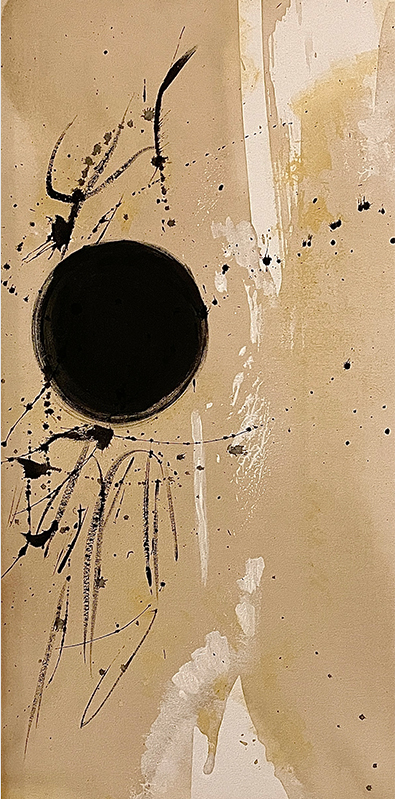
AARTI ZAVERI
“Unveiling myself, I express”
Aarti Zaveri identifies herself as an artist of the earth. And also she believes that the earth belongs to all. Taking the homocentric view to a different plane, Aarti functions as an artist of the inclusive world view. This perspective has helped her to move from a studio based art practitioner to an artist who could conjure up artistic projects in any given context transcending linguistic as well as geographical limits. Her creative verve has helped her to evolve into a worth reckoning site specific artist, video artist, installation artist and a performance artist, whose performances take their final form in the videos that she produces.
Born in Gujarat, one of the prosperous states in India, Aarti spent her childhood days among academicians and other family members who were inclined to art and design. She joined the illustrious Faculty of Fine Arts. Aarti kept her creative embers stoked up till they found fruition later in Delhi as she started her studio practice in early 1990s. Her graphic skills directed her initially towards making naturalist paintings which in fact had consolidated her position as an artist as she could gain commissions from the Indian Army and the Government of India to do official portraits of the Martyrs who had been conferred with the topmost gallantry awards.
Aarti however had a different calling as she grew tired of her super-naturalist style, and she directed herself to a semi-figurative and largely abstract style in her paintings where she dealt more with cosmic ideas related to human transcendence than the mundane subjects that an artist of her skill and craft would like to pursue. Oscillating between pure abstraction and semi-figuration, Aarti soon found her foothold in a painterly style which launched her into the second phase of her creative career. This naturally led her to extend her medium from the two dimensional ones to three dimensional. Instead of getting into sculpting, Aarti trasported her painterly thoughts into object based assemblages which slowly became autonomous installations. Adding kinetic and mobile appendages to her installations, she turned them into a sort of interactive installations.
She was the Vice President of the Green Aesthetic Organisation called ‘Trees’. This was a turning point for Aarti as she could bring herself to deal with natural objects sourced directly from the environments. This helped her go beyond the limitations posed by the objects in the artificially controlled situations; she realised that any object discarded or revered has an intrinsic aesthetical value and the artist’s job is to identify it and bring it back to the visual linguistic parlance. Once brought back in that way these objects, irrespective of their collection points, prove themselves as syllables that seek meaning in any kind of a language or system. Sometimes these objects, as Aarti observes, deconstruct an existing system and give birth to a new visual ensemble. Sooner than later Aarti realised her flourish in this language and its ability to express closer to heart ideas.
Taking a lot of inspiration from nature and the philosophies born out of nature, Aarti finds the similarities between feminine creativity and the feminine attributes of nature. At the same time she also recognises the ferocious power embedded within the feminine which could any time position itself as ‘feministic’ and ‘feminine’. The site specific installations that Aarti has done so far have got the early fruit gatherer’s simplicity and purposefulness. The genderless objects become gendered and the apparently powerless objects become powerful in such gathering. The meanings are slowly induced to the ensembles thus she creates and in turn the creations assume powerful messages pertaining to mindless development, conservation of water, fresh air and resources. Without being overtly sentimental towards the environmental issues, Aarti is able to keep a calm approach in framing the issues in an aesthetical fashion.
In the videos that Aarti has done so far, she becomes a protagonist/narrator whose perspective and actions come as interventions in the dominant discourses regarding women’s position and subjection. The protagonist at times turns herself into a narrator as well as the narrated. She becomes the text as well as the reader. This mutuality functions as a double mirror reflection that repeats endlessly creating the necessary depth and abstraction, while the meaning of the apparent remains powerfully conveyed to the viewers. Aarti’s artistic journey is now international and her installations and videos are selected for various international art expos.
2020 Guemgang International Video Art Festival, South Korea
2019 Nominated for ‘John Abraham International Short Film Festival’
2019 Nominated for ‘John Abraham International Short Film Festival’
2018 8 th Geumgang Nature Art Biennale, South Korea
2018 Guemgang International Video Art Festival, South Korea
2018 Installation ‘Padhaav’ at 2 nd Bodhgaya Biennale, India
2017 Seychelles Biennale (Most Prominent Artist Award)
2017 Global Nomadic Art Project France (residency)
2017 Global Nomadic Art Project Germany (residency)
2015-2016 Received Senior Research Fellowship from Ministry of Culture
2015 Global Nomadic Art Project India (residency)
2013 On occasion of Golden Jubilee of Nirmala Convent School, Awarded Most Inspiring Student in the field of Art of the School. Rajkot, Gujarat
2010 Award of Excellence from ‘Global Foundation’, New Delhi
2012 Certificate of Merit in recognition for the committed work from 7 Jat Regiments, Ministry of Defensc, Jaipur
2008 Certificate of Merit in recognition for the committed work for the Ministry of Defence by Defence Minister Shri A.K Anthony, New Delhi
2022 “Bulandshahr Legacy Festival”, Kali Nadi site specific installation UP, India
2019 ‘Second Self’ Solo Exhibiton Hosted by Trump Towers at The Oberoi Gurgaon
2018 ‘Mirroring the I’ permanent installation at Union Territory House By Lalit Kala Akademy Chandigarh
2016 ‘Spiraling Inspiration: Cosmic Chant’ installation Chandigarh
2016 ‘Elements of Being’ Solo Show at Lalit Kala Akademy, New Delhi
2016 ‘Spiraling Aspirations’ Installation, National Stadium, New Delhi
2014 ‘Timeless Moments’ Solo Show at Visual Art Gallery, India Habitat Centre, New Delhi
2013 Portraits of ‘Vir Chakra Awardees’ for 45 Brigade
2013 Golden Jubilee Painting for Army Headquarter, Jaipur
2013 Portrait of ‘Param Vir Charkra Awardees’ for the Army Headquarters, Jaipur
2012 ‘Pehchaan-Yatra Anterman Ki’ Ahemdabad
2011 Portraits of ‘Ashok Chakra Awardees’ permanently at South Block, Ministry of Defence, New Delhi
2011 ‘Pehchaan’ Solo Show at Lalit Kala Akademy, New Delhi
2010 Painting ‘Symbolic of fight against fear’ unveiled by Smt. Gursharan Kaur, wife of Hon’ble PM Manmohan Sigh during annual congregation of The Global Cancer Concern India
2009 Portraits of Martyrs who have received ‘Vir Chakra’ and ‘Kirti Chakra’ for Army Headquarters, Ranchi, Jharkhand
2008 Portraits of ‘Param Vir Chakra’ Awardees, South Block, Ministry of Defence, New Delhi
2021 ‘Yatra Nariyastu’ an exhibition at National Gallery of Modern Art (NGMA) New Delhi
2020 ‘Life + -‘ Reflections for Change, online exhibition with Italian architect and artist Elena, Italy
2017 ‘Sailing Faith’ Installation Imagine Fest GNAP, Nehru Park, New Delhi
2017 ‘Cosmic Chant’ Installation, Nehru Park, New Delhi
2017 Participated in India Art Fair, Ragini Art Gallery, New Delhi
2016 ‘Art Junction’ The Lalit, New Delhi
2015 ‘Spiraling Aspirations’ at India Art Festival
2014 Participated at India Art Festival, Lavanya Art Gallery, Mumbai
2014 Art:Gwangju South Korea
2014 Art Fair Swab Barcelona, Spain
2014 Art Festival Dubai, UAE
2014 Art edition, Seoul, South Korea
2014 ‘Nirbhaya – Multiple Expression’ IGNCA, New Delhi
2013 India Art Festival, Mumbai
2013 ‘’Ingenious Eclecticism’ Lalit Kala Akademy, New Delhi
2012 India Art Festival, Mumbai
2012 Auction at ‘Anonymous’ Art Show at C. K. Nayadu Hall, Mumbai
2012 United Art Fair, New Delhi
2011 ‘Many in Body, One in Soul’ Lalit Kala Akademy, New Delhi
2011 Epi Center, Gurgaon
2011 ‘Stree’ at Art Mall, New Delhi
2010 ‘A.A. Fair’ Singapore
2010 ‘Latent Heat’ Shridharni Art Gallery, Triveni Kala Sangam, New Delhi
2010 ‘8X6’ Lalit Kala Akademy, New Delhi
2010 ‘Serenity Art’ at India Habitat Centre, New Delhi
2009 Show for Thalassemics India Society (NGO), New Delhi
2006 2 nd All India International Art Exhibition, New Delhi
2005 Group Show at The Ashoka Hotel
Portrait Exhibition at Rajkot, Gujarat




